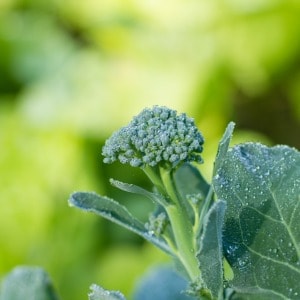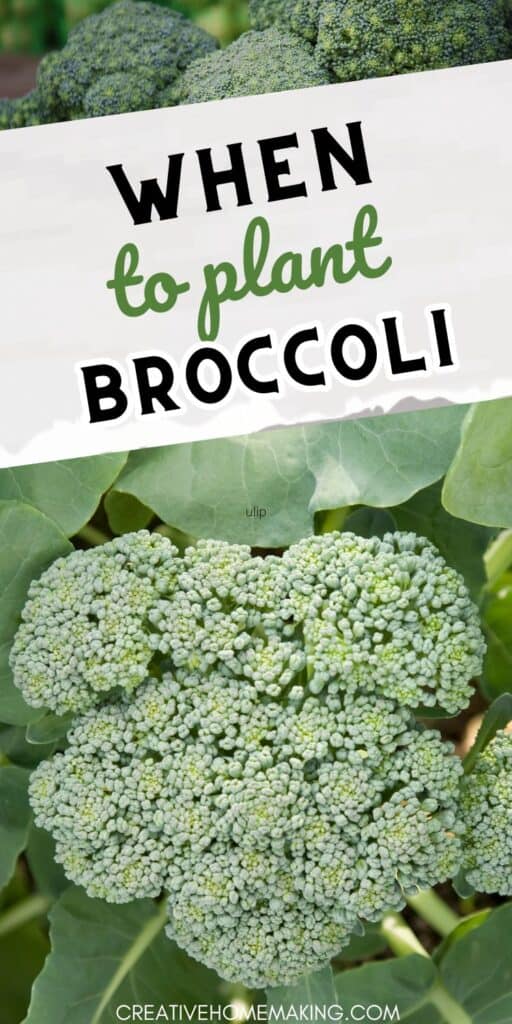When it comes to planting broccoli, timing is key. Knowing when to plant broccoli can make all the difference in the success of your crop. Broccoli is a cool-season vegetable that thrives in temperatures between 60-65°F (15-18°C), making it an ideal crop for spring and fall planting.
This post may contain affiliate links.
For spring planting, you should aim to plant your broccoli seeds 2-3 weeks before the last expected frost date in your area.
This will give your plants enough time to establish before the warm summer temperatures arrive. In most areas, this means planting in early to mid-spring. However, if you live in a warmer climate, you may need to plant earlier to avoid the hot summer temperatures.
Fall planting is also an option for broccoli. In fact, many gardeners prefer fall planting as the cooler temperatures and shorter days can result in sweeter and more tender broccoli heads.
For fall planting, you should aim to plant your broccoli seeds 85-100 days before the first expected frost date in your area. This will give your plants enough time to mature before the temperatures drop too low.
Understanding Broccoli
Broccoli is a member of the cabbage family, scientifically known as Brassica oleracea. It is a cool-season crop that is grown for its edible flower heads, which are rich in vitamins and minerals. In this section, you will learn more about broccoli’s botanical profile and popular varieties.
Botanical Profile
Broccoli is a cruciferous vegetable that belongs to the family Brassicaceae. It is a biennial plant that grows up to 3 feet tall and has large, dark green leaves.
The flower heads, also known as florets, are arranged in a tight cluster that resembles a tree. The florets are surrounded by thick, fleshy stems that are also edible.
Broccoli is a hardy plant that can tolerate frost and cold temperatures. It prefers well-drained soil that is rich in organic matter and requires full sun exposure to grow properly. Broccoli is usually grown as an annual crop and can be planted in both spring and fall.
Popular Varieties
There are several popular varieties of broccoli that are grown worldwide. Some of the most common ones include:
- Green Goliath: This variety produces large, green heads that are packed with nutrients. It is a hybrid that is resistant to many common diseases.
- Calabrese: This is the most popular variety of broccoli in the UK. It has a slightly milder taste than other varieties and produces large, blue-green heads.
- Flash: This is a fast-maturing variety that produces small, tender heads. It is ideal for growing in small gardens or containers.
- Green Magic: This variety produces medium-sized, dark green heads that are packed with flavor. It is a hybrid that is resistant to many common pests and diseases.
- Paragon: This is a heat-tolerant variety that produces large, blue-green heads. It is ideal for growing in warm climates.
Broccoli Rabe, also known as rapini, is a related vegetable that is popular in Italian cuisine. It has a slightly bitter taste and is often used in pasta dishes and salads.
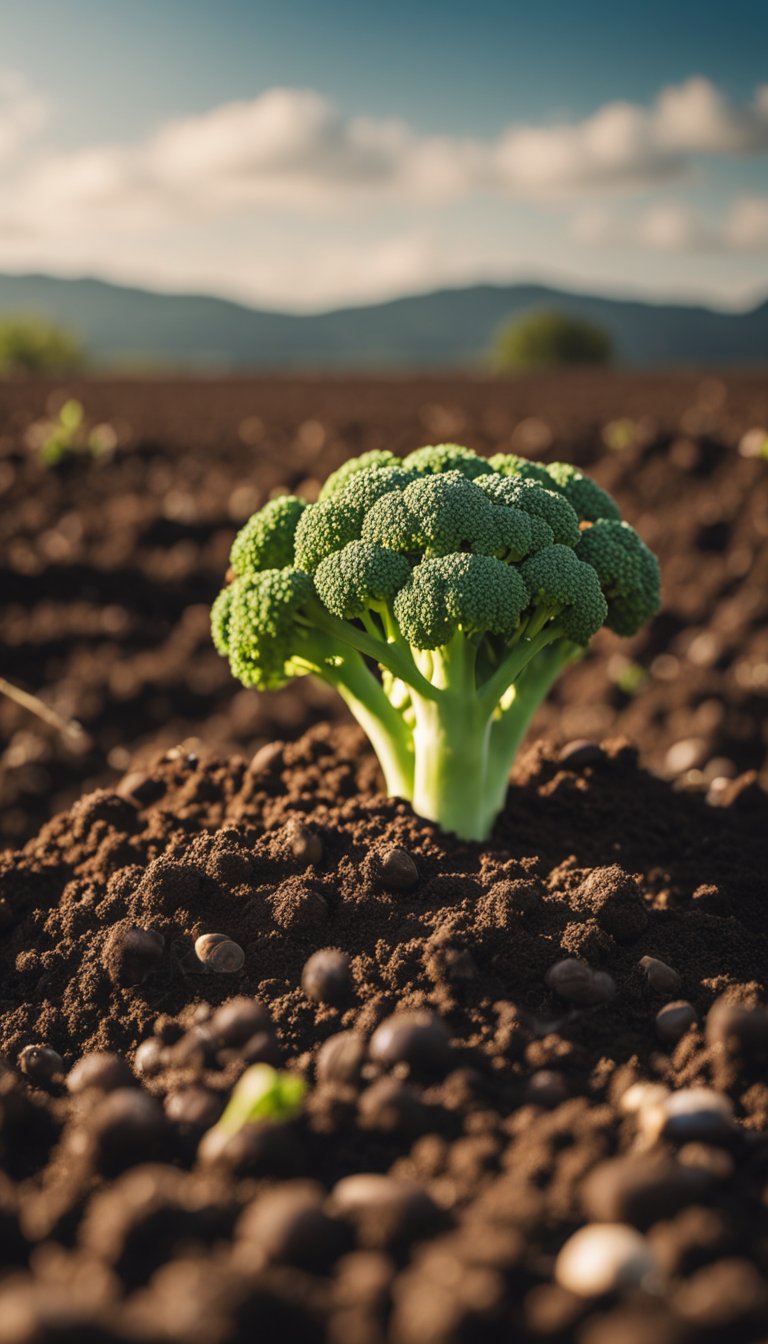
Pre-Planting Considerations
Before planting broccoli, it is important to consider a few key factors to ensure the best possible outcome. Here are some things to keep in mind:
Soil Preparation
Broccoli thrives in fertile soil with a pH level between 6.0 and 7.0. It is important to prepare your soil before planting by adding organic matter such as compost or well-rotted manure. This will help improve soil structure and drainage, as well as provide essential nutrients for your plants.
Choosing the Right Location
Broccoli requires full sun to grow properly, so it is important to choose a location that receives at least 6 hours of direct sunlight per day.
Additionally, broccoli should not be planted in areas where other members of the brassica family (such as cabbage or cauliflower) have been grown in the past 3 years, as this can increase the risk of disease.
Related Article: How to Blanch Vegetables for Freezing
Optimal Planting Times
Broccoli can be planted in both the spring and fall, but the timing will depend on your location and climate. In general, broccoli should be planted in the spring 2-4 weeks before the last frost date, or in the fall 85-100 days before the first expected frost.
Soil temperature should also be taken into account, as broccoli seeds will not germinate in soil temperatures below 40°F (4°C) or above 85°F (29°C).
By taking these pre-planting considerations into account, you can help ensure that your broccoli plants have the best possible start and yield a bountiful harvest.
Planting Process
When it comes to planting broccoli, there are a few different methods you can use. In this section, we’ll go over the three main ways to get your broccoli plants in the ground: starting from seeds, transplanting seedlings, and spacing and arrangement.
Starting from Seeds
If you want to start your broccoli plants from seeds, you’ll need to plant them indoors about six weeks before the last frost date in your area. You can use seed trays or small pots filled with potting soil to get started.
Plant the seeds about 1/4 inch deep and keep the soil moist but not waterlogged. Broccoli seeds need plenty of light and warmth to germinate, so keep them in a warm, sunny spot or use grow lights.
Transplanting Seedlings
Once your broccoli seedlings have grown to be about 4-6 inches tall, they’re ready to be transplanted into your garden. You should wait until after the last frost date in your area to do this.
When transplanting your seedlings, be sure to handle them gently and avoid damaging the roots. Plant them in rows with about 18-24 inches of space between each plant.
Spacing and Arrangement
When planting broccoli, it’s important to give each plant enough space to grow and thrive. You should plant your broccoli in rows with about 18-24 inches of space between each plant. This will give them plenty of room to spread out and get the light and nutrients they need.
Broccoli plants also need plenty of water, especially during the hot summer months. Be sure to water them regularly and deeply to keep the soil moist. You should also fertilize your broccoli plants every few weeks with a balanced fertilizer to help them grow strong and healthy.
Finally, it’s important to harden off your broccoli plants before transplanting them into your garden. This means gradually exposing them to the outdoor conditions over the course of a week or two before planting them in the ground.
This will help them adjust to the temperature and light changes and reduce the risk of transplant shock.
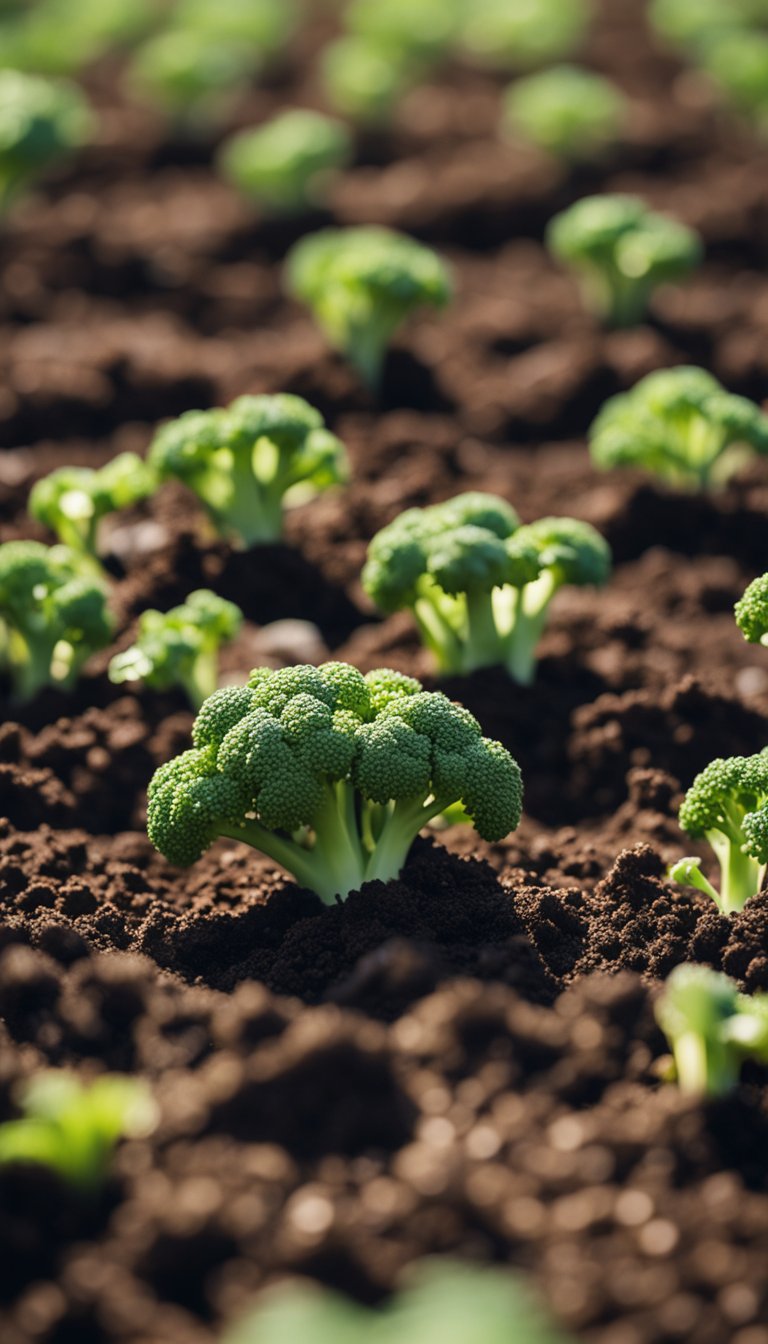
Caring for Broccoli Plants
Broccoli is a cool-season crop that requires proper care to grow and thrive. Here are some tips to help you care for your broccoli plants.
Watering and Nutrients
Broccoli plants require consistent moisture to grow properly. Water your plants regularly, especially during dry periods. Make sure the soil is moist but not waterlogged.
Broccoli plants also need nutrients to grow. Fertilize your plants with a balanced fertilizer that contains nitrogen, phosphorus, and potassium. Follow the instructions on the fertilizer package for the correct application rate.
Mulching and Weed Control
Mulching your broccoli plants can help retain moisture in the soil and prevent weed growth. Apply a layer of mulch around the base of your plants, taking care not to cover the stems.
Weeds can compete with your broccoli plants for nutrients and water. Pull weeds regularly or use a hoe to remove them.
Protecting from Pests and Diseases
Broccoli plants are susceptible to several pests and diseases, including aphids, cabbage loopers, cabbage root maggots, and clubroot. To prevent these pests and diseases, keep your garden clean and free of debris. Use row covers to protect your plants from insects.
If you notice any signs of pests or diseases, take action immediately. You can use bacillus thuringiensis to control cabbage loopers and other caterpillars.
Harvesting and Post-Harvest
Growing broccoli is a rewarding experience, but knowing when to harvest and how to preserve the vegetable can be a bit tricky. Here are some tips to help you identify the perfect time to harvest, techniques for harvesting, and storing and preserving broccoli.
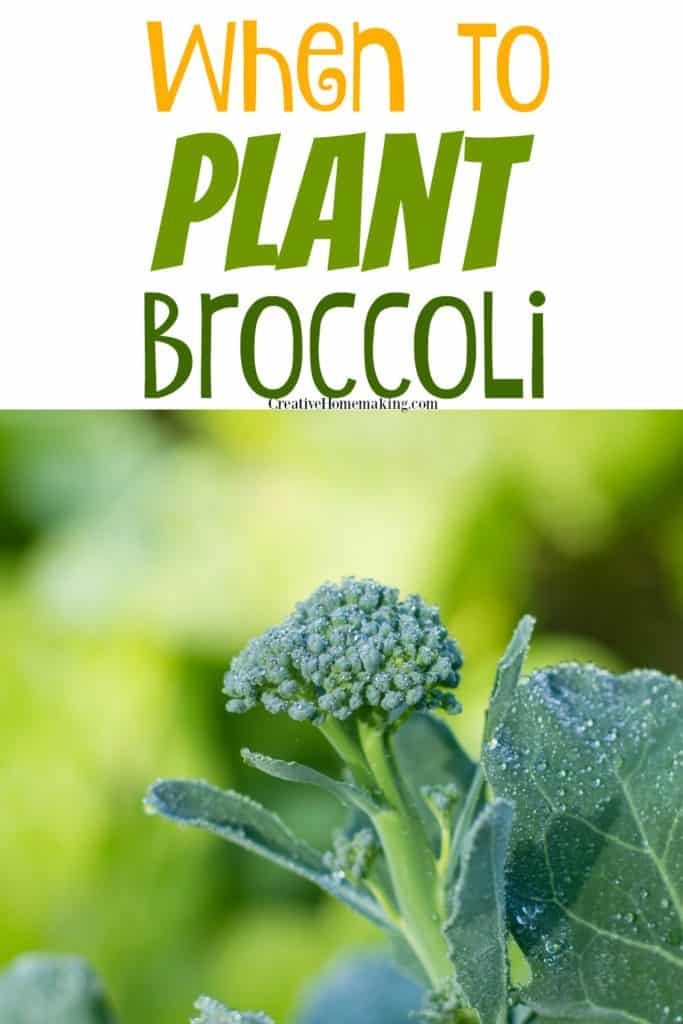
Identifying Harvest Time
The ideal time to harvest broccoli is when the head is tight and firm, and the buds are still closed. If you wait too long, the head will start to loosen and the flower buds will begin to open, which will result in a bitter taste.
You should also keep in mind that broccoli is a cool-season crop, so it’s best to harvest it during the fall harvest.
Techniques for Harvesting
When harvesting broccoli, it’s important to use sharp, clean shears to cut the stem about 6 inches below the head. This will encourage the plant to produce side shoots, which can also be harvested.
Be sure to leave at least one or two leaves on the plant so that it can continue to grow side shoots.
Storing and Preserving Broccoli
Broccoli can be stored in the refrigerator for up to a week, but it’s best to eat it as soon as possible for maximum flavor and nutrition. To preserve broccoli for longer periods of time, you can freeze it after blanching it for 3-4 minutes.
This will help to retain its color and texture. To blanch broccoli, simply boil it for a few minutes and then immediately transfer it to a bowl of ice water to stop the cooking process.
Related Article: Best Green Beans to Grow: Tips for a Bountiful Harvest
Additional Tips and Tricks
Companion Planting
Broccoli is a great vegetable to plant alongside other plants. It has been found to have a symbiotic relationship with plants like cauliflower, brussels sprouts, and kale.
These plants all belong to the same family, and planting them together can help to deter pests and diseases. Additionally, planting broccoli with herbs like rosemary, thyme, and sage can also help to repel pests.
Seasonal Considerations
When planting broccoli, it’s important to consider the season. Broccoli is a cool-weather crop that grows best in temperatures between 60-65°F.
Spring and fall are the best times to plant broccoli. In spring, plant your broccoli 2-3 weeks before the last frost date. In fall, plant your broccoli 85-100 days before the first frost date. If you live in a warmer climate, you can plant broccoli in winter.
Container and Raised Bed Gardening
Broccoli can be grown in containers or raised beds. If you’re growing broccoli in a container, make sure it’s at least 18 inches deep and wide. Use a well-draining soil mix and water your broccoli regularly.
If you’re growing broccoli in a raised bed, make sure the soil is well-draining and rich in organic matter. Broccoli needs plenty of space to grow, so make sure to space your plants at least 18 inches apart.
Overall, planting broccoli is a great way to add a healthy and delicious vegetable to your garden. By following these tips and tricks, you’ll be able to grow a successful crop of broccoli in no time!
Frequently Asked Questions
What is the best month to plant broccoli?
The best time to plant broccoli is during the cooler months of the year, such as early spring or fall. In most regions, this means planting broccoli in March or April for a spring harvest, or in August or September for a fall harvest.
How long does it take to grow broccoli?
Broccoli typically takes around 60 to 100 days to mature, depending on the variety and growing conditions. Some varieties mature faster than others, so it’s important to check the seed packet for specific information on your chosen variety.
How far apart should broccoli plants be spaced in the garden?
Broccoli plants should be spaced about 18 to 24 inches apart in the garden. This allows enough room for the plants to grow and mature without overcrowding each other.
Does broccoli prefer full sun or partial shade?
Broccoli prefers full sun, which means it should receive at least six hours of direct sunlight each day. However, it can also tolerate partial shade, especially during the hottest parts of the day.
Is there a recommended temperature range for growing broccoli?
Broccoli grows best in cool temperatures, with an ideal range of 60 to 65°F (15 to 18°C). However, it can tolerate temperatures as low as 40°F (4°C) and as high as 75°F (24°C).
Can you grow broccoli back every year or is it an annual plant?
Broccoli is an annual plant, which means it completes its life cycle in one growing season. While you can try to grow broccoli again the following year, it’s generally recommended to plant new seeds or seedlings each year for the best results.
Follow my gardening board on Pinterest.
